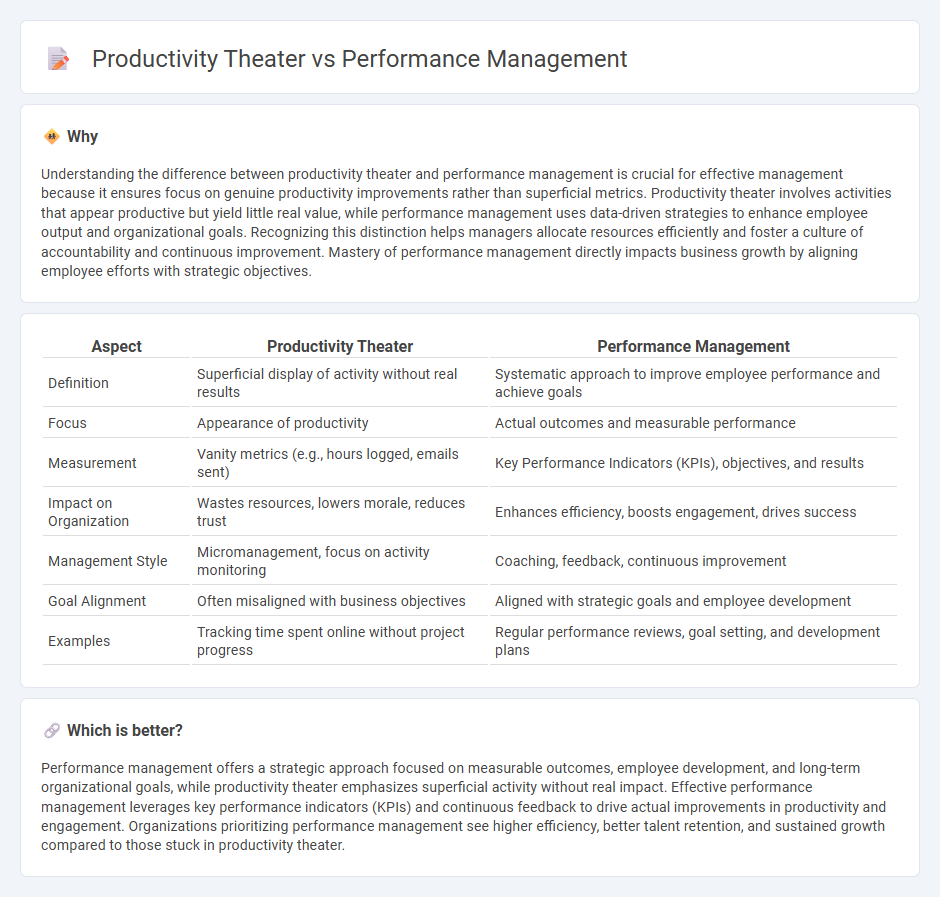
Productivity theater refers to superficial activities that create the illusion of efficiency without delivering meaningful results, often masking true performance issues within an organization. Performance management focuses on measurable outcomes and continuous improvement by aligning individual goals with organizational objectives and using data-driven evaluations. Explore effective strategies to distinguish genuine productivity from mere activity and enhance overall management practices.
Why it is important
Understanding the difference between productivity theater and performance management is crucial for effective management because it ensures focus on genuine productivity improvements rather than superficial metrics. Productivity theater involves activities that appear productive but yield little real value, while performance management uses data-driven strategies to enhance employee output and organizational goals. Recognizing this distinction helps managers allocate resources efficiently and foster a culture of accountability and continuous improvement. Mastery of performance management directly impacts business growth by aligning employee efforts with strategic objectives.
Comparison Table
| Aspect | Productivity Theater | Performance Management |
|---|---|---|
| Definition | Superficial display of activity without real results | Systematic approach to improve employee performance and achieve goals |
| Focus | Appearance of productivity | Actual outcomes and measurable performance |
| Measurement | Vanity metrics (e.g., hours logged, emails sent) | Key Performance Indicators (KPIs), objectives, and results |
| Impact on Organization | Wastes resources, lowers morale, reduces trust | Enhances efficiency, boosts engagement, drives success |
| Management Style | Micromanagement, focus on activity monitoring | Coaching, feedback, continuous improvement |
| Goal Alignment | Often misaligned with business objectives | Aligned with strategic goals and employee development |
| Examples | Tracking time spent online without project progress | Regular performance reviews, goal setting, and development plans |
Which is better?
Performance management offers a strategic approach focused on measurable outcomes, employee development, and long-term organizational goals, while productivity theater emphasizes superficial activity without real impact. Effective performance management leverages key performance indicators (KPIs) and continuous feedback to drive actual improvements in productivity and engagement. Organizations prioritizing performance management see higher efficiency, better talent retention, and sustained growth compared to those stuck in productivity theater.
Connection
Productivity theater involves creating the illusion of high efficiency without real output gains, often through superficial metrics or busywork. Performance management focuses on setting clear goals, tracking meaningful outcomes, and providing feedback to genuinely improve employee productivity. The connection lies in shifting from productivity theater to effective performance management to drive measurable results and organizational success.
Key Terms
Objective measurement
Objective measurement in performance management relies on quantifiable metrics such as key performance indicators (KPIs), output rates, and goal attainment percentages to drive genuine improvements, contrasting sharply with productivity theater that emphasizes superficial activity without tangible results. Effective performance management frameworks incorporate data analytics and continuous feedback loops to ensure accurate assessment and meaningful development. Explore strategies to distinguish real productivity from mere appearances in your organization.
Outcome-focused
Outcome-focused performance management emphasizes measurable results and continuous improvement, contrasting sharply with productivity theater that prioritizes busywork and superficial metrics. This approach leverages data-driven insights and goal alignment to ensure that employee efforts directly contribute to organizational success. Discover how adopting outcome-focused strategies can transform your workplace efficiency and drive genuine productivity.
Accountability
Performance management emphasizes clear goal setting, continuous feedback, and transparent accountability to drive measurable business outcomes. Productivity theater often involves superficial metrics and forced activity that mask true performance, hindering genuine accountability. Explore strategies to enhance authentic performance management and eliminate productivity theater for sustainable success.
Source and External Links
What Is Performance Management? The Complete Guide - Performance management is an ongoing process where managers and employees regularly communicate to assess job responsibilities and performance, using methods such as SMART goal setting and continuous feedback to foster growth and maximize organizational contribution.
What is Employee Performance Management? - Performance management balances the relationship between employees and business value through effective communication, goal setting, performance standards, and often involves technology to track and support ongoing feedback and development.
Performance Management - Human Resources - Performance management is a continuous process of communication and clarification of job responsibilities and expectations, incorporating goal setting, quarterly feedback sessions, and final performance evaluations aligned with organizational goals.
 dowidth.com
dowidth.com